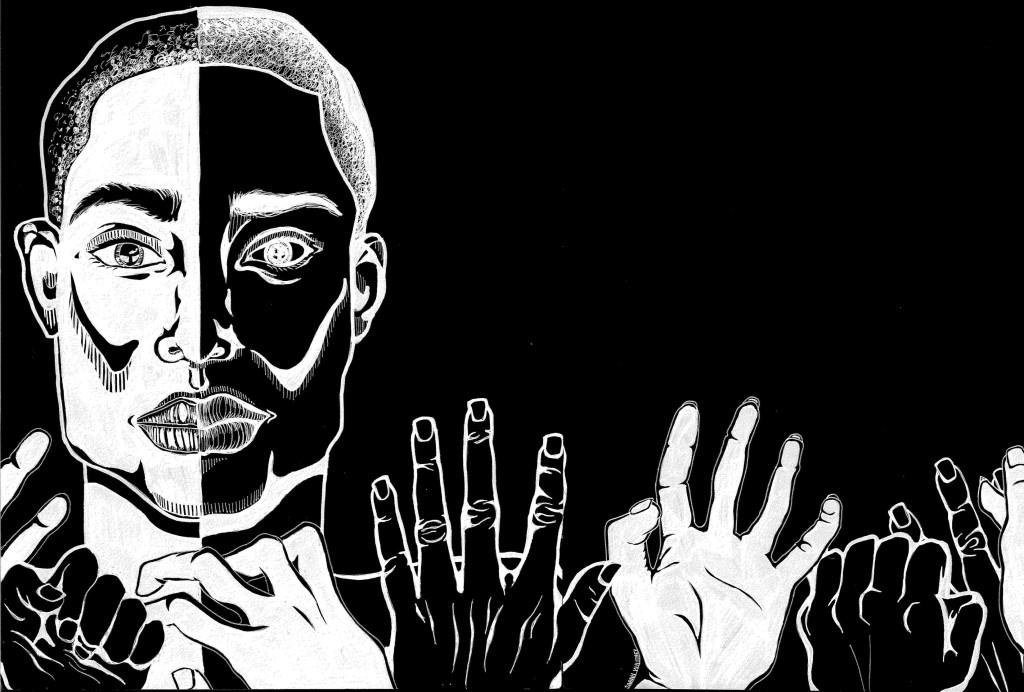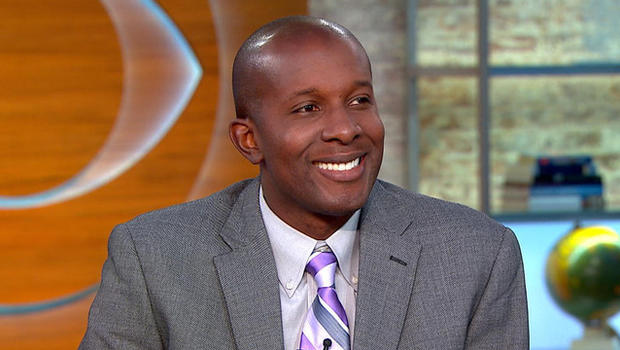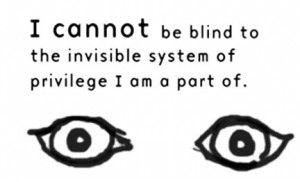Rachel Dolezal recently visited a daytime talkshow called The Real, where she answered the hosts’ questions about her racial identity and her views on the definitions of whiteness and blackness.
Tag: Racial Inequality
VIDEO: QI – Where are 1% Of Americans?
QI (Quite Interesting) is a British comedy panel game show hosted by Stephen Fry, which brings together four comedians a week to share anecdotes and trivia.
In this clip, Fry asks the panelists “Where are 1% Of Americans?”, which kicks off a conversation about mass incarceration, bringing to light unsettling details and statistics on racial disparity in the criminal justice system and the three-strikes law.
“No society in history has imprisoned more of its citizens”
While it’s illegal to import good made by forced labor or prisoners, American prisons produce “100% military helmets, bulletproof vests… and other items of uniform … 93% of domestically produced paints… 36% of home appliances”. It could be said that America “reinvented the slave trade”; these prisoners are paid way below minimum wage, allowing the country to compete with factories in third world countries.
“5% of the world’s population is American, 25% of people in jail worldwide are American.”
Though QI is a comedy show and this particular conversation ends in a laugh, it doesn’t detract from the gravity of the pervasive existence of racial discrimination and the business side of the American criminal justice system.
11 Types Of Racists
If there’s one thing to know about racism, it’s that racism (and race) is incredibly complex. Many people think racism means one group of people hates another group of people. However, racism manifests in all kinds of subtle and insidious ways. It operates on both a micro and macro level. For this reason, it’s so hard to talk about racism, or even recognize it when it’s going on.
So sorry, just because you’re not burning crosses on some black person’s lawn doesn’t necessarily mean you’re not part of the problem. It’s important that we recognize the different ways racism exists in the world, because being aware is the first step in fixing the problem. The fact of the matter is, there’s no one specific kind of racism or racist. There are many types of racists, and they come in all forms, from the blatant to to the inconspicuous. Below is a list of just a few of the different kinds….
Click here to read more.
VIDEO: How Racist Are You? with Jane Elliott
“For this Channel 4 documentary Jane Elliott, a controversial former schoolteacher from Ohio, is recreating the shocking exercise she used forty years ago to teach her nine year-old pupils about prejudice.
Elliott is asking thirty adult British volunteers – men and women of different ages and backgrounds – to experience inequality based on their eye color to show how susceptible we can all be to bigotry, and what it feels like to be on the other side of arbitrary discrimination.
Does Elliott’s exercise still have something to teach us four decades on and in a different country? Presented by Krishnan Guru-Murthy, the exercise is observed throughout by two expert psychologists, Prof Dominic Abrams and Dr Funké Baffour, who will be unpicking the behavior on display.”
Video: How racist are you?
Questions:
What do you think about this social experiment?
Are we all more racist than we realize or would like to admit?
Solving the School Discipline Gap

Joseph C. Phillip frames the debate in terms of students’ family life and single vs. two parent homes, rather than bigotry in school disciplinarians. He thinks that focusing only on race-talk on this issue will lead to unsatisfactory solutions that institutionalize the idea that there is something inherently different culturally that leads to black children misbehaving.
“A 2006 study claims Seattle school teachers discipline black students more than their white peers. How about a solution that doesn’t involve pulling the ‘race card?’ […] We can either march forward under the illusion that a discipline gap exists because teachers are a bunch of racists, suspending black children more than white for no other reason than the color of their skin. Or, we can finally realize that a breakdown in the traditional family structure, and an embrace of the destructive social behavior and attitudes that have accompanied it, is playing the devil with our children.”
Click here to read/listen to more.
Questions:
Do you agree of disagree with Phillip’s interpretation of this issue?
Do you think that solutions should be focused on race or family life? Another related factor? A mix of these?
The Two Asian Americas

“What have I made of myself and my children? … We cannot exercise our rights. Humility and insults, who is responsible for all this? Me and the American government. Obstacles this way, blockades that way, and bridges burnt behind.”
The quotation above was excepted from the 1928 suicide letter of Vaishno Das Bagai, an Indian immigrant victimized by racist Anti-Asian legislation which stripped him of his citizenship, property, employment, and ultimately, his self-esteem in America. This New Yorker article looks at history and the experiences of people like Bagai to explore how systemic racism continues to influence the lives of Asians in America. It describes the duality of the Asian American experience:
“There are now, in a sense, two Asian Americas: one formed by five centuries of systemic racism, and another, more genteel version, constituted in the aftermath of the 1965 law. These two Asian Americas float over and under each other like tectonic plates, often clanging discordantly. So, while Chinese-Americans and Indian-Americans are among the most prosperous groups in the country, Korean-Americans, Vietnamese-Americans, and Filipino-Americans have lower median personal earnings than the general population.”
Click here to read more.
This is the biggest surprise about America I’ve heard from foreign visitors
/cdn0.vox-cdn.com/uploads/chorus_image/image/47447452/GettyImages-491191436.0.0.jpg)
What do foreigners find extremely surprising about American culture? Comment your guess below and then click here to find out!
Black Man in a White Coat by Damon Tweedy, M.D.
“One doctor’s passionate and profound memoir of his experience grappling with race, bias, and the unique health problems of black Americans
When Damon Tweedy begins medical school, he envisions a bright future where his segregated, working-class background will become largely irrelevant. Instead, he finds that he has joined a new world where race is front and center. The recipient of a scholarship designed to increase black student enrollment, Tweedy soon meets a professor who bluntly questions whether he belongs in medical school, a moment that crystallizes the challenges he will face throughout his career. Making matters worse, in lecture after lecture the common refrain for numerous diseases resounds, “More common in blacks than in whites.”
Black Man in a White Coat examines the complex ways in which both black doctors and patients must navigate the difficult and often contradictory terrain of race and medicine. As Tweedy transforms from student to practicing physician, he discovers how often race influences his encounters with patients. Through their stories, he illustrates the complex social, cultural, and economic factors at the root of many health problems in the black community. These issues take on greater meaning when Tweedy is himself diagnosed with a chronic disease far more common among black people. In this powerful, moving, and deeply empathic book, Tweedy explores the challenges confronting black doctors, and the disproportionate health burdens faced by black patients, ultimately seeking a way forward to better treatment and more compassionate care.”

Click here – Time magazine book excerpt
COMIC: White Privilege, Explained
White privilege can be a tricky thing for people to wrap their heads around. If you’ve ever called out white privilege before, chances are you’ve heard responses like “But I’m didn’t ask to be born white!” or “You’re being reverse racist.”
The next time that happens, just show the nay-sayer this succinct comic by Jamie Kapp explaining what white privilege is — and what it isn’t.
Click through for the full comic!
VIDEO: 2 Videos by The Atlantic
Mass Incarceration, Visualized
The Enduring Myth of Black Criminality
Ta-Nehisi Coates explores how mass incarceration has affected African American families. “There’s a long history in this country of dealing with problems in the African American community through the criminal justice system,” he says in this animated interview. “The enduring view of African Americans in this country is as a race of people who are prone to criminality.”




